AREAS DEVASTATED BY THE SICHUAN EARTHQUAKE IN 2008
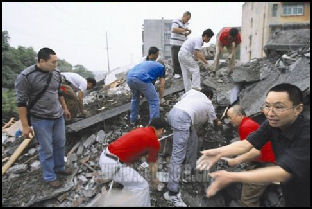
At 2:28 pm on May 12, 2008, a catastrophic earthquake measuring 7.9 or 8 on the Richter scale struck Sichuan Province, killing around 90,000 people and injuring nearly 363,000, destroying more than 15 million homes, leaving 10 million homeless and 1.5 million displaced and causing more than $20 billion in damage. It was the worst earthquake and disaster to strike China since the Tangshan earthquake in 1976. It came just 10 days after the a devastating cyclone hit Myanmar that killed tens of thousands of people.
Damage occurred over an area the size of South Korea. In towns and villages around the epicenter — about 200 kilometers from Chengdu, Sichuan largest city — more than 80 percent of the buildings were destroyed. In large cities entire apartment blocks collapsed or were made too dangerous to reside in. The hardest hit area were Wenchuan County in Sichuan and areas to the north. This is a mountainous area prone to landslides with some peaks over 5000 meters that drop steeply down into gorges and narrow river valleys, where some towns and villages were located. One Chinese geologist told AFP, “The mountains were basically shaken loose by the earthquake, causing mudlfows and landslides.”
Thousands were killed in the large towns Mianyang, Mian zhu and Denyang. Many of the hardest hit areas were occupied by the Qiang minority and Tibetans. Tangjiashan, a village of 4,000, was destroyed by a landslide. Hanwang was another devastated town. Lin Yang wrote in Time, “Unclaimed bodies lay under bloody sheets. A six-meter-tall statue of a rider on horseback has been decapitated by the violent shaking. The hands of a clock in a tower in the town square were struck as 2:28pm.”
The panda breeding center at Wolong near the epicenter was damaged. Forty-seven people in the vicinity of the center were killed. Three-five people at the center were injured but all 86 panda were safe Several pandas were moved because of concerns about food shortages. Emergency supplies of bamboo, bamboo shoots, apples and soy beans were sent for the pandas. All 144 pandas in Wolong, Chengdu and Xian were safe. The fate of the 1,500 pandas in the wild is unknown.
Parts of Gansu Province near the Sichuan border were devastated. In some counties 90 percent of the homes collapsed and dozens were killed. Among those affected were some of the poorest people in China, farmers in mountainous regions than earn less than $200 a year. Heavy rains after the quake exacerbated the situation. Government relief efforts were minimal. Many people complained. Some the dubbed the region the “forgotten disaster area.”
See Separate Articles SICHUAN EARTHQUAKE IN 2008: SURVIVORS, DEAD, IMPACT factsanddetails.com ; SICHUAN EARTHQUAKE, POORLY-BUILT SCHOOLS, ACTIVISTS AND PARENTS factsanddetails.com ; RELIEF AND REBUILDING AFTER SICHUAN EARTHQUAKE IN 2008 factsanddetails.com ; LIFE AFTER THE SICHUAN EARTHQUAKE IN 2008: REMARRIAGE AND BABIES factsanddetails.com ; EARTHQUAKES IN YUNNAN AND SICHUAN factsanddetails.com ; EARTHQUAKES IN CHINA: AREAS HIT, PREDICTIONS AND GRAFT factsanddetails.com ; POWERFUL EARTHQUAKES IN CHINA: TANGSHAN AND THE DEADLIEST EARTHQUAKE EVER factsanddetails.com
Websites on the Sichuan Earthquake: Images of the Sichuan Earthquake china-quake.com ; CNN Reports cnn.com/SPECIALS ; BBC Reports /news.bbc.co.uk ; New York Times Articles nytimes.com ; Wikipedia article Wikipedia ;
RECOMMENDED BOOKS: 2008 Sichuan Earthquake: “Shaken Authority: China's Communist Party and the 2008 Sichuan Earthquake” by Christian P. Sorac Amazon.com; “Wenchuan, Sichuan Province, China, Earthquake of 2008: Lifeline Performance” by Edited by Alex K. Tang, P.E., et al. Amazon.com; “When the Earth Shook: The Wenchuan Earthquake” by Sichuan Provincial Post-Wenchuan Earthquake Reconstruction Commission Office Amazon.com; “Rebirth of Our Land: Creating a More Beautiful Sichuan” by Sichuan Provincial Post-Wenchuan Earthquake Reconstruction Commission Office Amazon.com Earthquakes in China: “Earthquake Prediction: Nine Major Earthquakes in China (1966–1976)” by Zhengxiang Fu Yingzhen Zhang Zongjin Ma (1990) Amazon.com; “Earthquakes: the Plights of China: a 6.8 Magnitude Deadly Earthquake Hits China” by Carla Dermaco Amazon.com; “Natural Disasters in China” by Peijun Shi (2016) Amazon.com; “Economic Impacts and Emergency Management of Disasters in China” by Xianhua Wu and Ji Guo (2021) Amazon.com; Tangshan Earthquake in 1976: “Tangshan Earthquake: A Reportage to Tangshan Earth Quake in 1976 by Gang Qian and Zhengnian Wang (2022) Amazon.com; “Heaven Cracks, Earth Shakes: The Tangshan Earthquake and the Death of Mao's China” by James Palmer, Amazon.com
Damage Caused by the Sichuan Earthquake in 2008
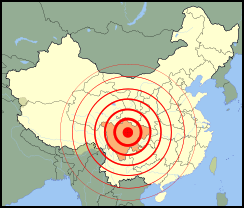
Communications were cut off; trains derailed and gas cars caught on fire; roads and airports were closed; underground water pipes ruptured; power and running water was cut off. About 800,000 pigs were killed. Images on television showed the twisted bodies of children packed together under the ruble of a pancaked school building, doctors amputating the legs of a trapped, dying girl in one last effort to save her.
In Beichuan County about 80 percent of the buildings were destroyed or damaged. “In the towns and villages around Mianzhu, everything speaks of collapse,” Leo Lewis wrote in the Times of London. “The trotters and snouts of crushed pigs poke out from pulverized buildings. Irrigation trenches are split and leaking or blocked and dry...Terraced farms have been overrun by landslides... Factories and mines are silent, their operations wrecked and their labor forces dead or evacuated.”
Recently-constructed building collapsed while old building were left. Slipshod construction was blamed for the collapse of many buildings, The foundations of many houses were hastily built on unstable slopes. When the earthquake occurred, in many cases, slopes gave way and the foundation and houses collapsed. Some houses of ethnic minorities were little more than piles of stones.
Many of the buildings that collapsed were built of bricks and concrete blocks that were not adequately reenforced. Kazuyoshi Onishir, a professor at Kobe University that specializes in city disaster management told the Yomiuri Shimbun, “Although houses are required to be built to withstand an earthquake....sufficient measures haven’t been taken to meet ths requirement...Because reinforcing buildings is expensive, quake-resistance measures have not been deployed.” Toshimi Kabeyasawa, a professor at Tokyo University said the building’s “pillars and beams were loosely joined, and the joints may have ben structurally weak and come apart easily.”

Many parents lost their only children which they were limited to have by China’s one child policy. A mother who lost her only child, a 13-year-old girl, told AP, “She died even before becoming a young adult. She never really knew what life was like.” A week after the quake parents were still desperately searching for their kids. Many children lost their parents, The Red Cross dispatched a team of mental health experts to the stricken region to help address the problem.
Direct economic losses were determined to be over $146 billion. Property losses were valued at $122.7 billion with 91 percent of the losses in Sichuan Province. More than 1.4 million people were in poverty after the quake. In many poor area, progress against poverty that took decades to put in place was wiped out in seconds. Many farmers that were prospering before the quake found themselves back in poverty.
Report on Building Damage in the Sichuan Earthquake
A report released in May 2009 determined that the majority of severely damaged buildings in the May 12 earthquake in Sichuan province were schools and factories. The report — prepared by scholars Experts from the Tsinghua University, Beijing Jiaotong University and Southwest Jiaotong University who inspected 384 buildings in seven cities of Sichuan soon after the earthquake — suggested that among the 44 school buildings inspected, 10 should not be used anymore, while 15 should be “demolished immediately.” In contrast, the scholars found that among the 54 government buildings they investigated, five should not be used and two must be demolished. The remaining 47 government buildings are fit for use, the report said.[Source: Xin Dingding China Daily, May 26, 2009]
Sixty-nine percent of 92 commercial and residential buildings checked were fit for use, either right away or after reinforcements, the experts, who specialize in building construction, found. They concluded that buildings “with a frame structure” - one supported by a frame of wood or steel or reinforced concrete - suffered the least damage.
Most government buildings used the frame structure, and therefore suffered the least damage, the report said. However, most school and factory buildings used a masonry structure instead of the frame structure and thus suffered maximum damage, it said. “The earthquake-proof performance of such masonry structure relies on rational anti-seismic design, strict implementation, and good construction quality,” it said.
The China Economic weekly quoted an unnamed expert as saying: “The use of substandard material during construction and the inability to follow anti-seismic designs are reasons why the buildings in Sichuan suffered so much damage.”
The investigation did not tread into the thorny area of determining the responsibility of the collapsed structures. Activist Ai Weiwei said, “We must give due respect to the facts. It's okay if they don't want to find out who is responsible for the collapsed buildings, but it's not okay to blur the truth.”
2008 Sichuan Earthquake Damage in Yingxu
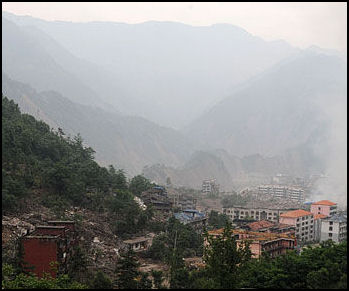
Yingxiu, a small town situated in a steep river gorge, was completely flattened by the earthquake. Located about 50 kilometers north of Dujiangyan, and nearer the epicenter than any other town, it lost an estimated two thirds of its 10,000 inhabitants to the quake. Almost no safe buildings were left. Mountain roads into Yingxui were blocked by dozens of landslides. The only way to get in or out was on foot or by helicopter.
A reporter for the Yomiuri Shimbun wrote: “We came across a collapsed section of elevated highway. Large areas of mountain surfaces around Yingxiu were bare, apparently due to landslides triggered by the earthquake...In the town it appeared that more 90 percent of the buildings had collapsed. It appeared that the number of rescue workers exceeded the number of survivors... who are living in tents...We saw a number of bodies carried to an open space near a riverbank and lined up there.”
Simon Elegant wrote in Time: “The highway leading to Yingxiu...is wrecked by fissures big enough to swallow a child and is choked with smashed trucks and enormous rocks. Near the town’s outskirts, just past a car that has been crushed by a boulder, a landside cuts off the road entirely.”
Jane Macartney wrote in the Times of London: “The Yingxu Middle School was a heap...its classroom tilted at crazy angles, crumpled one on top pf the other. Hidden from sight in the hill...are common graves where thousands who died this county have been buried.
2008 Sichuan Earthquake Damage in Dujiangyan
The historic city of Dujiangyan. 50 kilometers southwest of the epicenter, was one of hardest hit large population centers. More than 10 percent of the buildings were destroyed, including a high school, where 900 students were attending mid-afternoon classes, and a large market. Describing the scene there three days after the quake, AP reported: “police and militias...pulverized rubble with cranes and backhoes while crews used shovels to pick around larger pieces of debris. On one side street, about a dozen bodies were laid on the sidewalk, while incense sticks placed in a pile of sand sent smoke in the air as a tribute and to dull the stench of death.”
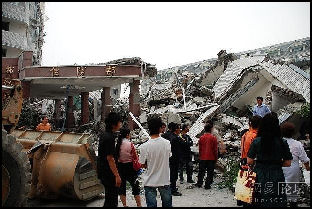
Lin Yang of Time reported; “Buildings are now just heaps of brick and concrete and corpses lie on the sidewalks. The rescue operation resembles an army assault. Military vehicles, ambulances and mobile kitchen are everywhere, Soldiers search for survivors in the debris and step in to control emotional crowds of victims’ relatives. Through the night loudspeaker-equipped trucks cruised the streets, appealing for calm: “The State Council, the Central Committee, the Sichuan, Chengdu and Dujiangyan governments are trying their best to help. Earthquakes are not something that mankind can avoid.” —
A 70-year-old man in Dujiangyan who was looking for his grandson in the rubble of a school told Time, “After the quake hit, I ran to the school and started removing rubble, I uncovered several children. Some we dead, some still alive, But I couldn’t find my grandson.”
Dujiangyan is a major tourist attraction, famed for its 2,000-year-old irrigation system. A survivor in Dujiangyan told AP, “When the earthquake happened, our home collapsed really quickly, and I heard my father yell, “Help, help, help.” Another told the Yomirui Shimbun. “The sudden violent jolt from beneath me really shocked me. It felt like my heart was popping out of my body.”
2008 Sichuan Earthquake Damage in Beichuan
Beichuan, the closest town to the epicenter, was also devastated. Situated in a narrow valley along a river bend, between towering Sichuan mountains, it stood nearly 60 miles north of the quake’s epicenter and was severely shaken by the quake and buried by landslides. The quake leveling 80 percent of the buildings in the old town and 60 percent of the buildings in the new town. Around 8,600 of the of the towns s 22,000 inhabitants, many of them members of the Qiang ethnic minority, were killed. More than 1,000 were killed in Beichuan Middle School alone.
Austin Ramzy wrote in Time: “Bodies jutted from the pancaked floors of collapsed buildings and lined rubble-strewn streets, tens of thousands of homeless crowded into two sports stadiums, and million more slept in tents, the highway was riven with cracks and smashed vehicles crowded the shoulders. Grim-faced survivors trudged past on foot. The surface of Zipingba reservoir was covered with a brackish film from the tons of boulders and soil loosed on it.”
A father who rushed to Beichuan No. 1 Middle School where his 16-year-old daughter was told Time, “The five-story building was completely flattened and young, broken bodies were everywhere. There were parents here and there, crying and digging for their children, and I did just the same. I cried and cried, dug and dug until the police stopped us.” Fours days later he found his daughter’s body and identified here by her cloth shoe that had been hand-made by her grandmother.
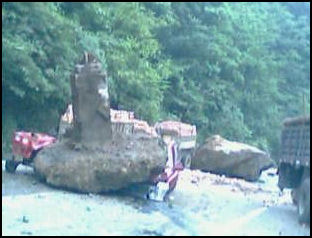
Mark Magnier wrote in the Los Angeles Times, “At the Royal JIS Paris Clothing store, a looter tried on a white shirt...Farther down the alley, several bodies lay on the ground, some covered haphazardly with yellow silk curtains from a nearby shop...Most victims were reported to have died quickly, but I’m haunted by the body of one large man. By the looks of it, he had lived long enough for some good Samaritans to place him on a bed frame and fashion makeshift stretcher handles before abandoning him to save their own skin.”
,”On the road to Hanwang a middle-aged man paced back and forth atop a mound of rubble, watching a machine slowly tear away giant chunks of concrete from the pile. The object of everyone’s attention was his wife of 24 years buried in the remains of the house. Hoping against hope that she was still alive he’d been waiting for three days by this time, some spent digging with his own hands...Now and again he would retreat under a tree, where relatives would comfort him...Finally her lifeless body was uncovered. It was not where here the family expected to find her.”
Jane Macartney wrote in the Times of London, “Beichuan is only for the dead. Entombed in the ruins, thousands are still missing and their bodies may never be recovered...A mass of tangled beams...chunks of concrete and broken walls is almost all that remains of the main county town. The few remaining streets, scattered with beer bottles, children’s shoes and scraps of paper, are empty...No building is undamaged,” In the Old Town “debris stands seven stories high and rubble is piled up like matchsticks.”
When the earthquake struck landslides came down slopes on both sides of the river. Most buildings collapsed or fell over. Ironically Beichuan had been moved to its current location from another site because of concerns about earthquake dangers there. Beichuan is located in the only Qiang ethnic minority county in China. A plan calls for Beichuan to be left in its devastated state as a memorial to the earthquake and a new entire town to be rebuilt at a new location.
Secondary Disasters, Health Care and Disease After the Sichuan Earthquake in 2008
There were worries that heavy rains and aftershocks could set off secondary disasters such as floods, landslides, or mudslides, The earthquake was followed by heavy rains and more than 6,000 aftershocks in the first week alone. These destroyed and damaged more buildings, produced landslides and mudslides, and dammed rivers. A large aftershocks that measured 6.4 on the Richter scale that occurred about two weeks after the main quake killed eight people, injured 1,000 and destroyed or damaged 270,000 houses,
Some hospitals and health care facilities were destroyed. Others were damaged badly enough so they were unusable. Doctors, nurses and patients were among those that were killed in the collapsed Dujiangyan Hospital of Traditional Chinese Medicine. Medicines and equipment in that hospital were destroyed. Doctors that were uninjured were able to provide only rudimentary treatment. Severely injured were sent to hospitals in Chengdu. .
Functioning hospitals were packed. Many had tent cities outside of them filled with patients. Not everyone who needed care got it because of shortages of doctors, nurses, medicines and equipment and the inability of those who needed care to get to hospitals. There were reports of dozens of survivors developing gas gangrene — a bacteria infection that produces gas within muscle tissues and releases a horrible smell. ong odor.

Many rescued survivors suffered from crush syndrome, a serous medical condition in which muscle tissues subjected to crushing pressure for a long period of time break down, causing protein to flow into the blood, damaging the kidneys and eventually leading to kidney failure.
There were concerns of people drinking water contaminated with bacteria from the feces and urine of humans and farm animals and the outbreak of infectious diseases like measles and dysentery. Measles was a concern because the inoculation rate in the area was low. Garbage heaps attracted hordes of flies.
Survivors suffered from mental problems, dealing with the loss of loved ones and property, as well as physical problems. In a move that surprised many, teams of psychologists, counselors and volunteers were sent into to help, with particular attention focused on traumatized children.
The Water Resources Ministry said that 69 dams were damaged by the quake in central Sichuan Province and some were in danger of bursting. The Three Gorges dam was not damaged.
Dangers from Quake-Produced Lakes After the Sichuan Earthquake in 2008
Thirty five dangerous lakes were created by landslides that blocked rivers. In some many cases the natural dams created by the landslides were not very strong and there was a danger that the dam could collapse, releasing a torrent below the dam, sweeping away everything in its path. Matters were made worse by heavy rains that filled up the lakes at a faster rate than expected. Hundreds of thousands of survivors living down stream from these lakes were forced to evacuate. In 1933 an earthquake in the same area produces a massive landslide that creating an instant dam and large lake, Fifty years later part of the dam washed away in heavy rain and part of the lake was released.
Tangjiashan Lake is the largest of the quake-created lakes. Created by a huge landslide and located about three kilometers from the quake epicenter, it held a huge volume of water and for a while was rising at a. rate of almost two meters a day.
About 200,000 people living below Tangjiashan Lake, including all the residents in the villages of Jiuling and Qinglian, were evacuated About 150,000 people in the large town Mianyang were moved to higher ground or forced to leave completely. Another 1 million were told to prepare to leave. In some places soldiers made their point that people needed to get by spray painting lines on buildings that showed where waters would reach if the dam burst,
Soldiers were put to work digging channels to relieve pressure on the dams. If a lake overflows a dam there is a good chance the water will erode the earth and dam might collapsed. A channel helps relieve pressure on the dam and allows the water to ease out. At Tangjiashan Lake bulldozers and earthmovers were dropped by helicopters and soldiers were sent in on foot, carrying 10 kilograms of explosives, to build a channel and create emergency escape paths in the event the dam burst. More than 600 troops spent six days, working around the clock, building a channel that was 500 meters long and 19 meters wide, meant to drain off water from the lake in a controlled manner. Once the channel at Tangjiashan was finished and opened, water gushed through the man-made sluices. But still water in the lake continued to rise so soldiers used anti-tank weapons and 82 millimeter recoilless guns to blast away rocks and muck to increase the flow of water and drain the lake so it no longer presented a threat.
By mid June the sluice was finished, draining more than half the 250 million cubic meters of water in Tanjianshan Lake in matter of a few hours. Water poured through the sluice, down, low-lying evacuated towns, where more than 200,000 once lived, easing the threat to 1 million residents further downstream. Muddy brown water from Tanjianshan Lake poured into evacuated Beichian center and seeped up the side streets. A Sichuan official called the sluice a “decisive victory.”
A smaller quake lake at Majingxiang burst its banks. Witnesses said that bodies of people killed in the earthquake shot out amid the the torrent of gravel and rock and sludge. A construction worker who working at the lake said, “We were releasing water through a manmade channel about two meters wide, but then it suddenly gave way and there was this roaring sound and we ran up the side of the hill.” No one was reported injured in the incident, which took place in an isolated valley

Geology of the Sichuan Earthquake in 2008
The Longmenshan fault on which the earthquake occurred is 250 kilometers to 300 kilometers long and 30 kilometers wide. During the quake the earth may have moved as much as 13 meters, an incredibly large movement for an earthquake. The largest shift occurred in a mountainous area in Wenchuan county, about 50 kilometers northeast of the epicenter. The shaking continued for sometime because the fault shifted for about two minutes. Examinations bedrock appear to indicate the destruction began at the epicenter and advanced in a northeasterly direction.
Scientists believe the Longmenshan Fault sheered in two places: along a 100-kilometer-long and 30-kilometer-wide section that sheared up seven meters and another section — about 150 kilometers long and 30 kilometers wide — to the northeast of the first section that sheared about four meters. The first section moved for about 50 seconds and then 10 seconds later the second section moved for about 60 seconds.
The quake’s strength and magnitude was caused by the release of a huge amount of accumulated seismic strain built up from two colliding tectonic plates. The Longmenshan Fault lie on a north-south seismic belt that stretches across Sichuan and Yunnan Provinces that was created by the pressure from the Indian subcontinent and Indian-Australian Plate pushing against the Eurasian plate, which has also pushed up the Himalayas. Seismic waves generated by the quake circled the globe 2½ times. At one observatory in Japan the seismic waves were recorded at 2:41pm., again at 5:10pm and again at 8:40pm Beijing time.
There are three main fault lines in Sichuan: Xianshuihe, Anninghe and Longmenshan. Longmenshan is the closest fault to Chengdu. Chengdu, the largest city to the epicenter, emerged relatively unscathed because it lies on the relatively geologically stable Sichuan basin and Yangtze massif. Not a single fatality was reported despite the city with a population of over 10 million.
Prof. Koshun Yamaoka of Nagoya University told the Yomiuri Shumbun, “Large-scale shearing of faults is likely to cause long-lasting seismic waves, which are transmitted to distant places. The focus was relatively shallow: between 10 kilometers and 20 kilometers under the earth’s surface. The shock waves that were generated were in the form of “Lg waves” that traveled through continental crust at shallow depths, reaching a maximum depth of 35 kilometers under the surface. Because the crust which China sits on is relatively unbroken and uniform in consistency the Lg waves lost little of their strength in the same way that lights travel through fiber optic cables. This explains why the earthquake still packed a strong jolt when it reached Beijing 1,500 kilometers away from the epicenter and Shanghai, over 1,700 kilometers away.”
In February 2009, scientists said that pressure caused by the weight of water in a reservoir behind a dam built along geologic fault lines may have played a role in triggering the earthquake. The 156-meter-high Zipingpu dam, the region’s largest, is only 550 meters from fault lines and 5.5 kilometers from the quake epicenter, The weight of the water in the reservoir behind the dam was estimated to be 315 million tons, enough to possible cause the quake or cause it be worse than it might have been.
Even though it was well-known that the region was prone to severe earthquakes little preparations had been reduce the dame from such an earthquake or be ready for rescue if such an earthquake took place. There was some discussion of giving greater credibility to reports of strange animal behavior as a predictor of earthquakes. Before the Sichuan quake there were reports of mass migrations of frogs and toads near the quake region.
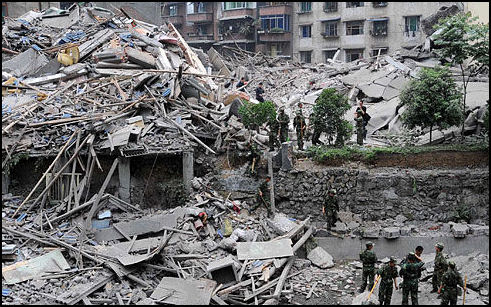
Could a Dam Have Triggered the Sichuan Earthquake?
Some scientists have claimed that pressure from the weight of waters behind Zipingpu Dam, a large dam in Sichuan which stands just five kilometers from the epicenter, could have helped to trigger the Sichuan earthquake. Fan Xiao, a chief engineer at the Sichuan Geology and Mineral Bureau, said earthquake in May 2008 was the largest in the area for thousands of years and suggested that the weight of the reservoir's waters — 315 million tons — was a key factor. [Source: Tania Branigan, The Guardian, February 5, 2009]
“I'm not saying the earthquake would not have happened without the dam, but the presence of the massive Zipingpu dam may have changed the size or time of the quake, thus creating a more violent quake,” he told the Associated Press in a telephone interview. Fan said sudden changes in the water level — like the rapid drop at Zipingpu shortly before the quake — could greatly destabilize an existing fault.” He added that he had opposed the dam's construction in 2003 because he was worried about such a disaster and was concerned that dams are now being built on the Dadu and Jinsha rivers to the west and north-west of the quake zone.
Scientists agree that dams can produce tremors. But several today played down the claims that this was an issue in Sichuan, arguing that the area lies on an active fault line and that the shock was too great for the reservoir to be a major factor.
Christian Klose, a geophysical hazards research scientist from Columbia University in New York, has also suggested the extra water could have triggered the earthquake. But in a blog posting on the subject he warned: “Scientific evidence for such a statement is needed! Some questions need to be answered: How much water was impounded, where and when? Did resulting stress changes alter stresses deep in the Earth's crust? Were stress alterations significantly large enough? Where was the highest seismic energy release — close to the reservoir?”
Dr Alex Densmore of Durham University, who was studying the Sichuan fault before the quake and has carried out further work there since, said he was “pretty skeptical.” “The fault the earthquake happened on is active; we know there have been earthquakes there in the past and geologically that happened yesterday — just a few thousand years ago. It's impossible to say whether or not the reservoir might have advanced the time of the earthquake, but if it did so it did it by a very short period. The size of the earthquake is ultimately determined by the length of the fault which breaks and how far the two sides move relative to each other. A reservoir by itself isn't going to affect those things It won't give you a bigger earthquake than you would otherwise have had.”
Dr Roger Musson of the British Geological Survey said the Aswan Dam was a good example of how large reservoirs could produce earthquakes in previously unaffected areas. But he said he would be extremely doubtful that the Sichuan dam had played a role unless there was a record of smaller quakes dating back to when it was filled. Musson added: “That kind of [induced] earthquake can go up to magnitude 6.5, let's say. This earthquake was totally outside that level and was on a 300-kilometer-long rupture. That's a major tectonic fault.”
Geological Impact of Sichuan Earthquake 2008
The earthquake increased stresses on faults in the region, according to U.S. geologists, increasing the likelihood of aftershocks or even a major earthquake up to 240 kilometers away.
Strain was released in one area on the fault only to build up in another part of the fault. Yuzo Ishikawa of Japanese Magnetic Observatory told the Yomiuri Shumbun, “In the past after a big earthquake hit the area, another bg quake was observed nearby. People should remain on alert for some time.” In the 1970s earthquakes measuring 7 on the Richter scale occurred in the Sichuan and Yunnan seismic belt every few years, Following that was a period of period when quakes measuring 6 on the Richter scale occurred. In June 2007, a quake measuring 6.4 on the Richter scale struck Yunnan Province.
Image Sources: China-quake.com, Xinhuanet, Wikipedia, USGS, YouTube
Text Sources: New York Times, Washington Post, Los Angeles Times, Times of London, National Geographic, The New Yorker, Time, Newsweek, Reuters, AP, Lonely Planet Guides, Compton’s Encyclopedia and various books and other publications.
Last updated June 2022
